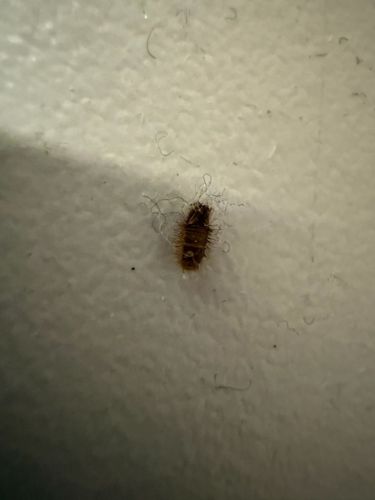Carpet beetle larva
Scientific Name: Dermestidae (various genera and species, e.g., Anthrenus, Trogoderma)
Order & Family: Order: Coleoptera, Family: Dermestidae
Size: 2-5 "mm" (larva)

Natural Habitat
Indoors, commonly found in dark, undisturbed areas such as closets, attics, under furniture, in carpets, and around baseboards where lint, pet hair, and food debris accumulate. They also infest natural fibers like wool, silk, fur, and feathers.
Diet & Feeding
They are scavengers and detritivores. Their diet primarily consists of keratin-containing materials such as wool, fur, feathers, silk, animal hides, pet hair, and dead insects. They also consume dried food products, cereals, and lint.
Behavior Patterns
Carpet beetle larvae are typically slow-moving and prefer dark, undisturbed locations. They exhibit a characteristic 'hairy' or 'bristly' appearance due to setae (hairs) on their bodies, which can sometimes break off and cause irritation. They undergo several molts before pupating. Larval stage is the damaging stage, as adults primarily feed on pollen and nectar outdoors.
Risks & Benefits
Potential risks include damage to household items made of natural fibers (carpets, clothing, upholstery, taxidermy, museum specimens). The hairs (setae) from the larvae can cause allergic reactions, skin irritations (dermatitis), or respiratory issues in sensitive individuals. They are generally not considered beneficial in a household setting, though in nature they play a role in decomposition.
Identified on: 11/3/2025